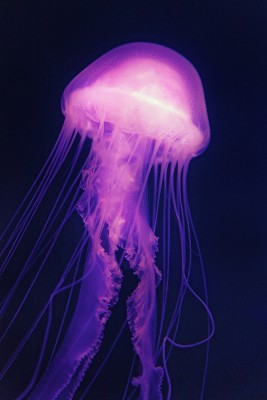- Home
- Marine Life
- Exploring the Enigmatic World of Jellyfish
Table of Contents

Diving into the vast blue expanse of the ocean, one encounters a realm teeming with life, mystery, and wonder. For women who scuba dive, each descent beneath the waves offers a chance to explore the beauty and diversity of marine ecosystems. Among the myriad creatures that inhabit these underwater worlds, one group stands out for its ethereal beauty and enigmatic nature: jellyfish.
As ocean lovers and scuba divers, understanding jellyfish is not just about appreciating their beauty; it’s about recognizing their ecological significance and learning to coexist with these mesmerizing creatures in their natural habitat.
Jellyfish: The Basics
Jellyfish belong to the phylum Cnidaria, a diverse group of aquatic animals that also includes corals and sea anemones. They are characterized by their gelatinous bodies and radial symmetry, which sets them apart from most other marine organisms. Despite their name, jellyfish are not actually fish; they are invertebrates, lacking a backbone.
The evolutionary history of jellyfish traces back millions of years, making them one of the oldest inhabitants of the ocean. Fossil records indicate that jellyfish-like creatures have existed for over 500 million years, evolving and adapting to various environmental changes over time.
One of the most striking features of jellyfish is their simplicity of form, which belies their complex ecological roles. With no centralized nervous system or brain, jellyfish rely on a diffuse network of nerves and sensory structures to perceive their environment and coordinate their movements. This simplicity, coupled with their remarkable adaptability, has enabled jellyfish to thrive in diverse marine habitats, from coastal waters to the open ocean.
The world of jellyfish encompasses a stunning array of shapes, sizes, and colors, with thousands of species distributed throughout the world’s oceans.
Jellyfish can be found in virtually every marine environment, from the sunlit surface waters to the dark depths of the abyss. They play vital roles in marine food webs, serving as both predators and prey for a wide range of marine organisms. Understanding the diversity and distribution of jellyfish species is essential for comprehending their ecological significance and the broader dynamics of marine ecosystems.
Jellyfish Anatomy:
Jellyfish come in many different sizes, shapes, and colors, but they all have a few characteristics in common.
The Bell
The bell, or umbrella, is the characteristic jelly-like structure that gives jellyfish their distinctive appearance. Composed primarily of a gelatinous substance called mesoglea, the bell provides buoyancy and enables jellyfish to move through the water column. The shape and size of the bell vary among different species, ranging from small, transparent bells to large, domed structures.

Tentacles
Dangling from the edge of the bell are long, trailing tentacles. These tentacles aren’t just for show – they’re equipped with tiny weapons called nematocysts. These stinging structures help jellyfish capture prey and scare off predators. The number and placement of these tentacles differ depending on the type of jellyfish, reflecting how they find food and survive in their environment.
Oral Arms
Not all jellyfish are just stingers and a bell! Some species have special tools called oral arms. These frilly appendages dangle from the underside of the jellyfish’s bell, right by its mouth. Oral arms aren’t just for show – they help jellyfish eat! Covered in stinging cells, they grab prey and then move it towards the mouth for digestion.
Nerve Net
Instead of a central control center, they have a network of nerve cells spread throughout their body called a nerve net. This diffuse system allows them to sense their surroundings, coordinate their movements, and react to things happening around them. While it’s not as complex as what you’d find in a fish or human, this nerve net is perfectly suited for a jellyfish’s life drifting and pulsing through the ocean.
The Ecological Role of Jellyfish
In the underwater world, jellyfish are both predators and prey.
Fish, sea turtles, and even seabirds find jellyfish on their menu. Jellyfish are a crucial food source for many species. Depending on how plentiful jellyfish are, it can even affect how many predator populations there are and where they’re found.
On the other hand, Jellyfish are opportunistic eaters, always on the lookout for a snack. They use their tentacles to capture a variety of tiny organisms floating in the water. Some jellyfish even actively hunt for small fish, crustaceans, and other zooplankton. By keeping these populations in check, jellyfish help maintain a healthy balance in the ocean’s ecosystem.
Jellyfish Blooms
A jellyfish bloom occurs when there is a population surge caused by ideal conditions for reproduction, such as plentiful food sources. While these blooms do occur naturally, human factors can often make them worse, putting a serious strain on the marine environment. Thankfully, the majority of blooms are short-lived.
Precautionary Measures and First Aid for Jellyfish Stings
Before heading underwater, divers should be aware of potential jellyfish hazards. Checking local conditions for jellyfish activity is crucial. This includes researching seasonal patterns and any known bloom events in the area.
Wearing the right dive gear also plays a big role in minimizing the risk of getting stung. Exposure suits with gloves can provide a physical barrier against jellyfish tentacles.

What to Do if You Get Stung
If a jellyfish encounter does occur, staying calm is key. Avoid sudden movements that could irritate the sting further. The safest course of action is to promptly exit the water and seek help from your dive buddies or dive professionals, especially if you experience severe pain or symptoms of an allergic reaction.
Jellyfish Sting First Aid
For basic first aid, rinse the affected area with seawater to remove any lingering tentacle fragments. Following that, applying a mild alkaline solution, like baking soda mixed with seawater, can help neutralize the venom.
The Top Places To Dive With Jellyfish
If you’re interested in the opportunity to observe jellyfish while diving, the following locations offer a high probability of encountering various species of jellies!
- Prince William Sound, Alaska: Moon jellyfish have large blooms here in the summer.
- Tojoman Lagoon, Philippines: Visit here to see white spotted jellyfish all year round, however, summer is the best time to visit.
- Waikiki Beach, Hawaii: You’ll find Box jellyfish. Blooms typically occur one week after a full moon!
Last but not least is Jellyfish Lake, a marine lake located on Eil Malk island in Palau. You can swim with golden jellyfish here, however, a high concentration of toxic hydrogen sulfide 40-50 feet below the surface prevents diving.












